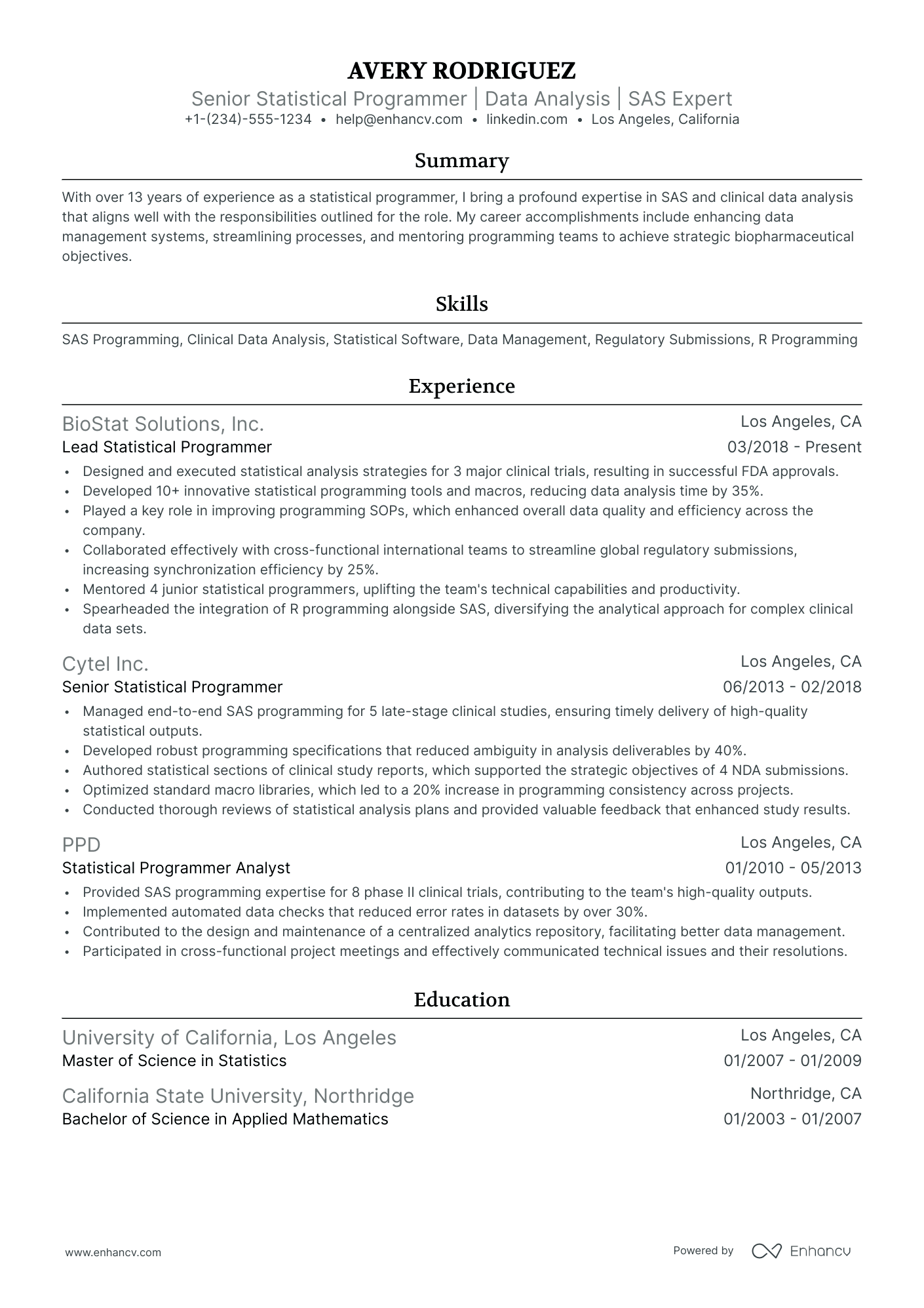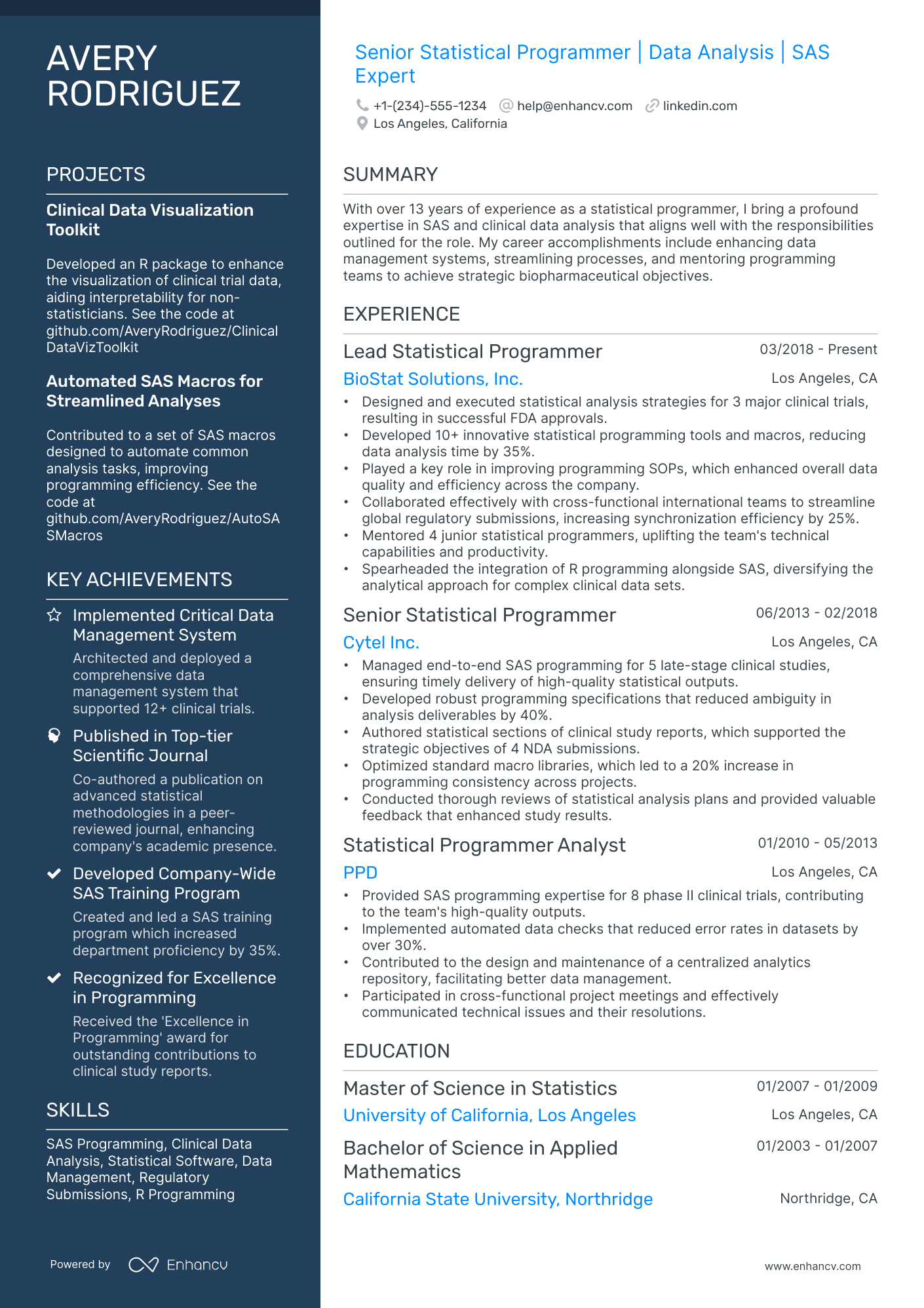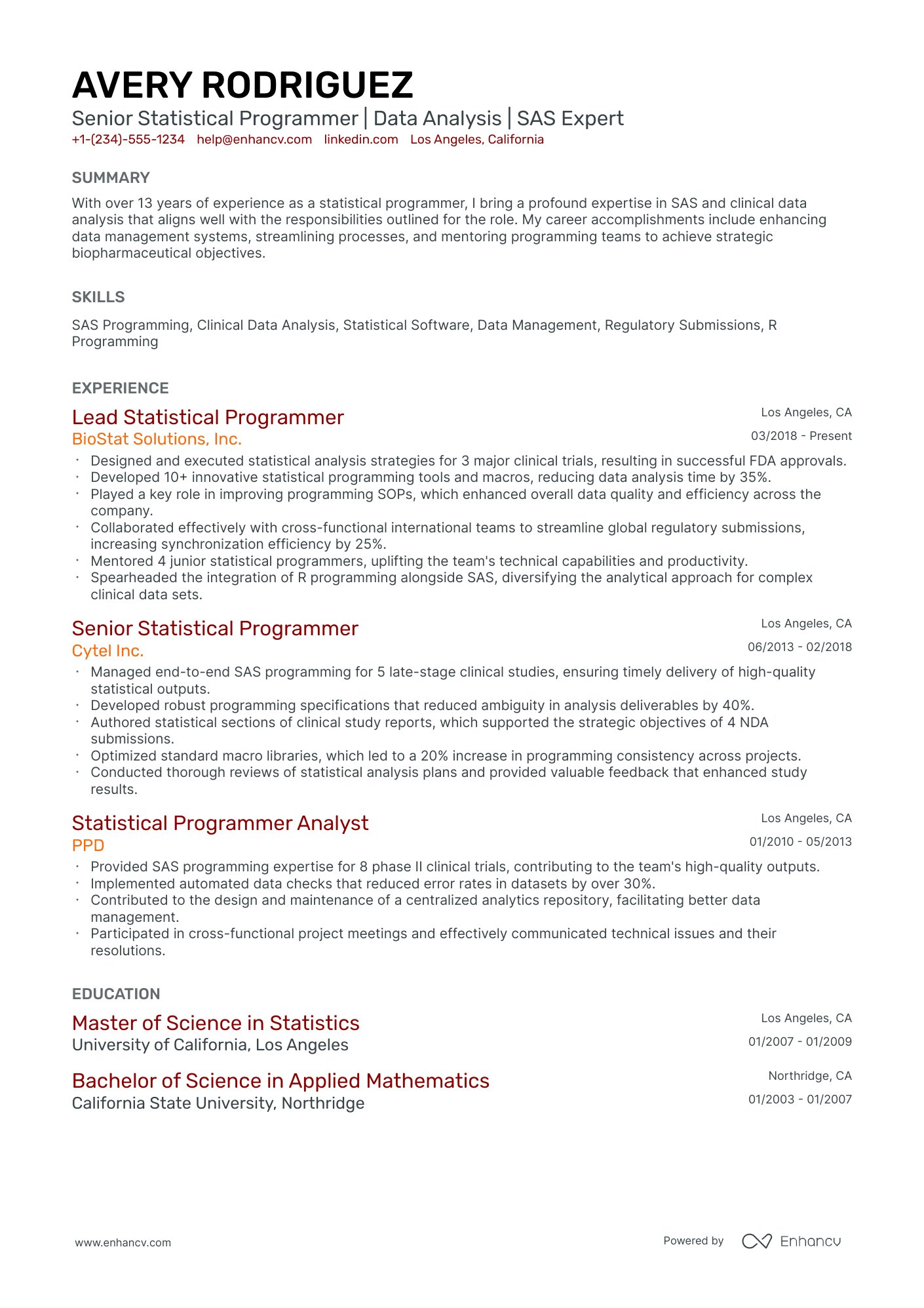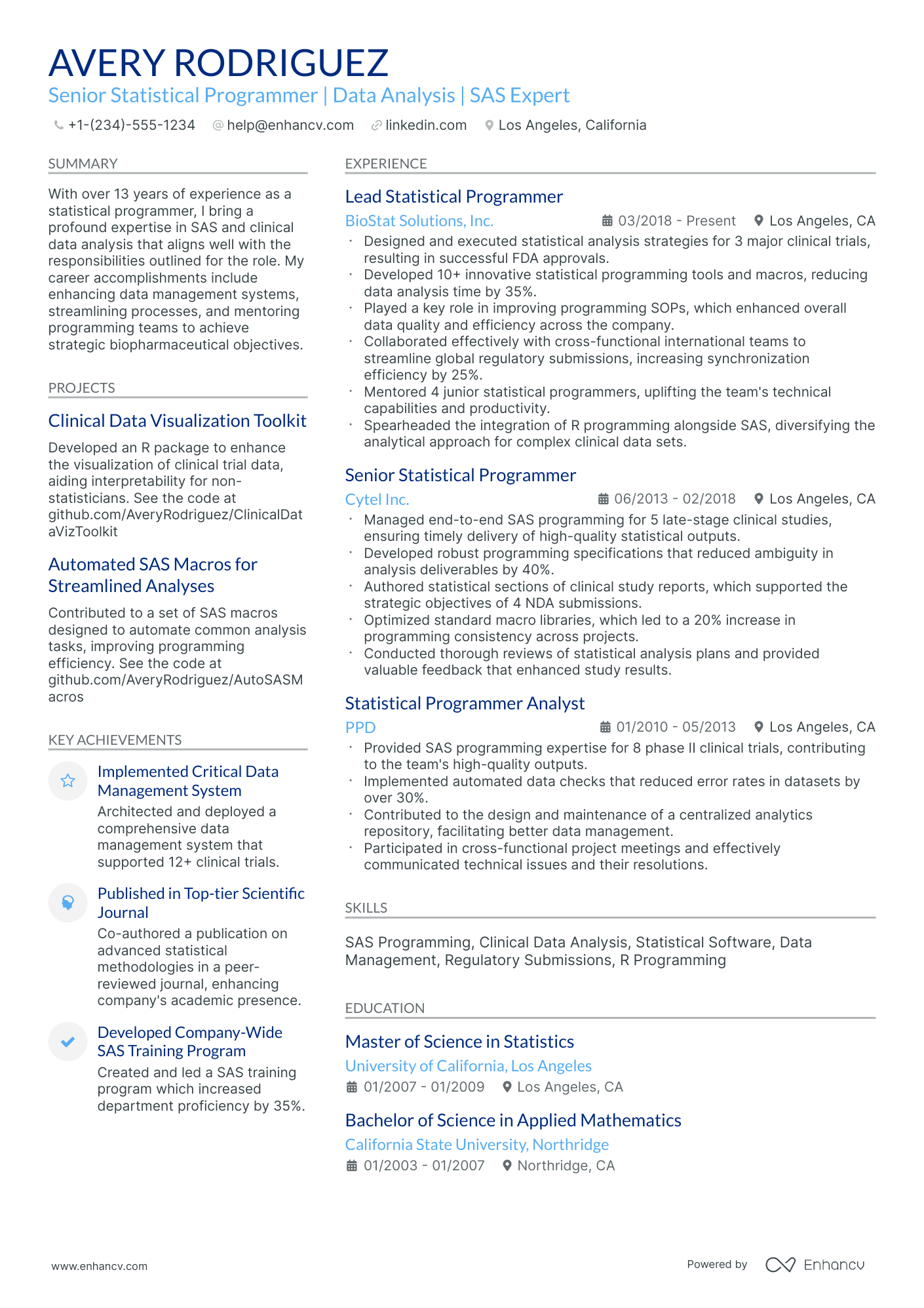As a statistical programmer, you might struggle to concisely express the complexity of your projects without overwhelming the reader with industry-specific jargon. Our guide offers strategies for simplifying technical language and tailoring your resume to highlight key achievements that resonate with potential employers, ensuring you make a strong impression.
- Incorporate statistical programmer job advert keywords into key sections of your resume, such as the summary, header, and experience sections;
- Quantify your experience using achievements, certificates, and more in various statistical programmer resume sections;
- Apply practical insights from real-life statistical programmer resume examples to enhance your own profile;
- Choose the most effective statistical programmer resume format to succeed in any evaluation process.
Optimize your statistical programmer resume format to pass the recruiters' assessment
You may be wondering just how much time you need to spend on designing your statistical programmer resume.
What recruiters are looking for is systematised content that is clear and coherent. Thus, your statistical programmer resume needs to answer requirements and why you're the best candidate for the role from the get-go.
Often, a clear layout consists of:
- Sorting your experience in the reverse chronological order - starting with your most recent and relevant roles. This is an excellent choice for more experienced professionals;
- Writing your contact information (e.g. personal phone number and email address) and your portfolio or LinkedIn link in your statistical programmer resume header. If you're wondering to include a photo or not, always make sure that it's appropriate for the country you're applying in;
- Use the basic, most important statistical programmer resume sections - your experience, education, summary, etc. Use your resume's real estate wisely to tell a compelling, professional story and match job description's keywords;
- Don't go overboard with the length of your resume. One page is absolutely fine if you happen to have under a decade of relevant experience.
Are you still wondering if you should submit your statistical programmer resume in PDF or Word format ? The PDF has a few more advantages, as it doesn't change the format and the text can't be altered upon application.
Format matters most when your statistical programmer resume is assessed by the Applicant Tracker System (or the ATS).
The ATS parses resumes, looking for specific keywords, skills or experience that match the job description.
P.S. We recently did a study on how the ATS works and were able to demystify three of the biggest misconceptions about how it assesses candidate resumes.
To pass the ATS evaluation, select any of the serif or sans-serif fonts. Popular choices that would help your statistical programmer resume stand out include Raleway, Exo 2, Montserrat, etc.
Most traditionalists go for Arial or Times New Roman, but it's often the case that many candidates choose these fonts, and you'd thus lose points on the uniqueness front.
Tailor your resume format to the job market – a Canadian resume, for example, might differ in layout.
Upload & Check Your Resume
Drop your resume here or choose a file. PDF & DOCX only. Max 2MB file size.
PRO TIP
If you happen to have plenty of certificates, select the ones that are most applicable and sought-after across the industry. Organize them by relevance to the role you're applying for.
The key to your statistical programmer job-winning resume - present your expertise with these sections:
- A header to make your resume more scannable
- Snapshot of who you are as a professional with your resume soft skills, achievements, and summary or objective
- Job advert keywords in the skills section of your resume
- Resume experience quantifying your past job successes with metrics
- A relevant education, certification, and technical sills section to provide background to your technological/software capabilities
What recruiters want to see on your resume:
- Proficiency in statistical programming languages (e.g., R, SAS, Python).
- Experience with database management and data manipulation (e.g., SQL).
- Familiarity with advanced statistical analysis methods and machine learning algorithms.
- Demonstrated ability to interpret complex datasets and communicate findings effectively.
- Experience with data visualization tools and techniques (e.g., Tableau, ggplot2 in R).
Defining your professional expertise in your statistical programmer resume work experience section
The work experience section, often the most detailed part of your resume, is where you discuss your past roles and achievements. To effectively list your experience, consider these four key tips:
- Align your expertise with the job requirements. It's vital to integrate keywords matching the job criteria to pass initial assessments;
- Show, don’t just tell. Quantify your responsibilities by stating your actual achievements in previous roles;
- Include measurable metrics. For instance, how did your performance impact the annual ROI?
- Highlight crucial industry skills. Mention both technological knowledge and interpersonal skills in this section.
These guidelines will help you craft an impressive statistical programmer resume work experience section that is bound to catch recruiters' attention.
- Developed complex statistical models for large-scale clinical trials with over 5,000 participants, enhancing drug efficacy analysis.
- Automated data cleaning processes, reducing errors by 30% and increasing the reliability of clinical trial results.
- Collaborated with cross-functional teams, contributing to the submission of 4 New Drug Applications (NDAs) to the FDA.
- Orchestrated the migration of statistical analysis processes to a new SAS platform, resulting in a 20% increase in performance efficiency.
- Led a team of junior programmers in the development of statistical algorithms that improved data analysis throughput.
- Authored comprehensive documentation on statistical programming best practices, enhancing the department's knowledge base.
- Implemented advanced predictive models for targeted marketing strategies, leading to a 15% increase in customer conversion rates.
- Conducted extensive data validation, ensuring the integrity and accuracy of analyses used in strategic decision-making.
- Facilitated training workshops on R and Python for statistical analysis, empowering the team with new analytical skills.
- Integrated machine learning methods into traditional statistical analysis, boosting predictive accuracy by 25%.
- Managed the processing and analysis of complex datasets with over 10 million records, driving insights into customer behavior trends.
- Spearheaded the development of an interactive dashboard for real-time data visualization used by the company’s executive team.
- Optimized big data workflows using Apache Hadoop, reducing processing times for large-scale genomic data by 35%.
- Developed custom statistical packages in R for biomarker discovery, contributing to the advancement of precision medicine.
- Engaged in the analysis of Phase II clinical trial data, delivering insights that propelled the development of a new cancer therapy.
- Played a pivotal role in a team that designed a novel algorithm for anomaly detection, which reduced false positives by 40% in fraud analysis.
- Utilized advanced statistical models to interpret data from over 100 clinical trials, contributing to more effective study designs.
- Created robust standard operating procedures for statistical analysis that improved project timelines by 15%.
- Enhanced statistical programming capabilities by integrating AI techniques, improving the accuracy of market risk assessment models.
- Trained a cohort of 20 new hires in CDISC standards and efficient programming practices, significantly elevating team competency.
- Directed the analysis of multi-source data, resulting in the development of a comprehensive patient adherence program.
- Drove the adoption of cloud-based platforms for statistical analysis, leading to a 50% reduction in data processing time for cross-functional teams.
- Led the validation of statistical software according to regulatory standards, ensuring compliance in all programming activities.
- Innovated analytical methods that supported the design of Phase III clinical trials, paving the way for the launch of a breakthrough therapy.
The following content includes information from "O*NET OnLine" by the U.S. Department of Labor, Employment and Training Administration (USDOL/ETA). Used under the CC BY 4.0 license. The data represents the top responsibilities present on the task lists for statistical programmer professionals.
Top Responsibilities for Statistical Programmer:
- Analyze and interpret statistical data to identify significant differences in relationships among sources of information.
- Evaluate the statistical methods and procedures used to obtain data to ensure validity, applicability, efficiency, and accuracy.
- Report results of statistical analyses, including information in the form of graphs, charts, and tables.
- Determine whether statistical methods are appropriate, based on user needs or research questions of interest.
- Prepare data for processing by organizing information, checking for inaccuracies, and adjusting and weighting the raw data.
- Develop and test experimental designs, sampling techniques, and analytical methods.
- Identify relationships and trends in data, as well as any factors that could affect the results of research.
- Present statistical and nonstatistical results, using charts, bullets, and graphs, in meetings or conferences to audiences such as clients, peers, and students.
- Design research projects that apply valid scientific techniques, and use information obtained from baselines or historical data to structure uncompromised and efficient analyses.
- Adapt statistical methods to solve specific problems in many fields, such as economics, biology, and engineering.
Quantifying impact on your resume
- Highlight the number of datasets you've cleansed and analyzed to showcase your hands-on experience with data preprocessing.
- Specify the size of the largest dataset you have worked on to demonstrate your ability to handle large volumes of data.
- Include the number of statistical models you've developed to illustrate your proficiency in statistical modeling.
- Quantify the efficiency improvements in data processing you've introduced, such as reduced runtime, to display your optimization skills.
- Document the percentage increase in prediction accuracy or other model performance metrics you've achieved to show your contribution to project outcomes.
- Mention the number of programming languages and statistical tools you are proficient in to emphasize your technical versatility.
- State the number of cross-functional teams you've collaborated with to highlight your teamwork and communication capabilities.
- Quantify any reductions in error rates or improvements in data quality you've implemented to underscore your attention to detail and quality assurance.
Action verbs for your statistical programmer resume
What if you don't have any experience?
There are two very common scenarios about candidates with less experience. They are either:
- Fresh out of college in search of a statistical programmer role
- Transferring over from a completely different field
Both of these types of candidates still have a shot at landing their first job in the industry.
All they need to do about the experience section of their statistical programmer resume is:
- Consider their strengths - would the outcomes of their previous roles or niche skill sets impress recruiters? Feature those towards the top of your resume
- Exclude any and all irrelevant experience items - remember that at the end of the day, you're telling a story that aims to align with the ideal candidate for the statistical programmer job
- Win recruiters over with personality - perhaps your ambition, dreams, and diligence would make you the perfect fit for the statistical programmer role. Dedicate resume space to detail your personality traits by showcasing how they've helped you succeed in past roles
- Tailor your experience to specific job requirements - ensure your statistical programmer resume answers the advert in the best way possible.
Recommended reads:
PRO TIP
If you happen to have some basic certificates, don't invest too much of your statistical programmer resume real estate in them. Instead, list them within the skills section or as part of your relevant experience. This way you'd ensure you meet all job requirements while dedicating your certificates to only the most in-demand certification across the industry.
Featuring your hard skills and soft skills on your statistical programmer resume
The skills section of your statistical programmer resume needs to your various capabilities that align with the job requirements. List hard skills (or technical skills) to showcase to potential employers that you're perfectly apt at dealing with technological innovations and niche software. Meanwhile, your soft skills need to detail how you'd thrive within your new, potential environment with personal skills (e.g. resilience, negotiation, organization, etc.) Your statistical programmer resume skills section needs to include both types of skills to promote how you're both technical and cultural fit. Here's how to create your bespoke statistical programmer skills section to help you stand out:
- Focus on skill requirements that are listed toward the top of the job advert.
- Include niche skills that you've worked hard to obtain.
- Select specific soft skills that match the company (or the department) culture.
- Cover some of the basic job requirements by including important skills for the statistical programmer role - ones you haven't been able to list through the rest of your resume.
Get inspired with our statistical programmer sample skill list to list some of the most prominent hard and soft skills across the field.
Top skills for your statistical programmer resume:
SAS Programming
R Programming
Python
SQL
Statistical Analysis Software (e.g., SPSS)
Data Visualization Tools (e.g., Tableau, ggplot2)
Clinical Trial Data Standards (e.g., CDISC)
Version Control Systems (e.g., Git)
Data Manipulation Techniques
Database Management
Attention to Detail
Problem-Solving
Communication Skills
Team Collaboration
Time Management
Critical Thinking
Adaptability
Project Management
Analytical Mindset
Organizational Skills
Next, you will find information on the top technologies for statistical programmer professonals from "O*NET OnLine" by the U.S. Department of Labor, Employment and Training Administration (USDOL/ETA). Used under the CC BY 4.0 license.
Top technologies for Statistical Programmer’s resume:
- IBM SPSS Statistics
- The MathWorks MATLAB
- Microsoft PowerPoint
- C++
- R
PRO TIP
List all your relevant higher education degrees within your resume in reverse chronological order (starting with the latest). There are cases when your PhD in a particular field could help you stand apart from other candidates.
Showcase academic background with education and certifications' sections
Listing your education and certifications should be a rudimentary part of your resume writing.
Including your relevant academic background - in the form of your higher education degree and niche-specific certificates - will prove knowledge of the industry.
For your education section:
- Start by including your degree, followed by start and graduation dates, as well as the institution;
- You could include relevant coursework, major/minor , or GPA, only if your've just graduated from college or if this information would further support your application;
- If you have an "ongoing" degree, you can still list it in case you think your diploma can impress recruiters or it's required;
Follow a similar logic for your certifications section by listing the institution, alongside dates you've obtained the certificate. For some of the most recent and relevant industry certificates , check out the next part of our guide:
The top 5 certifications for your statistical programmer resume:
- Certified Professional in Healthcare Quality (CPHQ) - National Association for Healthcare Quality (NAHQ)
- Microsoft Certified: Data Analyst Associate (MCDAA) - Microsoft
- SAS Certified Advanced Analytics Professional Using SAS 9 (SAS AACP) - SAS Institute Inc.
- Microsoft Certified: Azure Data Scientist Associate (MCADSA) - Microsoft
- IBM Data Science Professional Certificate (IBM DSPC) - IBM
The content below includes information from "O*NET OnLine" by the U.S. Department of Labor, Employment and Training Administration (USDOL/ETA). Used under the CC BY 4.0 license. The data represents the top associations for statistical programmer professionals.
Top US associations for a Statistical Programmer professional
- American Statistical Association
- American Academy of Actuaries
- American Educational Research Association
- American Mathematical Society
- American Society of Human Genetics
PRO TIP
The more time and effort you've put into obtaining the relevant certificate, the closer to the top it should be listed. This is especially important for more senior roles and if the company you're applying for is more forward-facing.
Recommended reads:
Should you write a resume summary or an objective?
No need to research social media or ask ChatGPT to find out if the summary or objective is right for your statistical programmer resume.
- Experienced candidates always tend to go for resume summaries. The summary is a three to five sentence long paragraph that narrates your career highlights and aligns your experience to the role. In it you can add your top skills and career achievements that are most impressive.
- Junior professionals or those making a career change, should write a resume objective. These shouldn't be longer than five sentences and should detail your career goals . Basically, how you see yourself growing in the current position and how would your experience or skill set could help out your potential employers.
Think of both the resume summary and objective as your opportunity to put your best foot forward - from the get go - answering job requirements with skills.
Use the below real-world statistical programmer professional statements as inspiration for writing your resume summary or objective.
Resume summaries for a statistical programmer job
- With over eight years of dedicated experience in statistical programming, particularly within the pharmaceutical industry, this candidate has honed robust SAS programming skills, contributing to the successful submission of three New Drug Applications. Recognized for developing complex algorithms that improved data analysis processes, they aim to leverage their expertise to advance clinical trial analysis.
- Transitioning from data analytics in the financial sector to statistical programming, this individual brings 5 years of experience with Python and R coding languages. They successfully automated financial reporting systems, which increased efficiency by 40%. Eager to apply their analytical skills and technical knowledge to support biostatistical projects.
- Seasoned data scientist with a rich 10-year background in machine learning, transitioning into statistical programming. This candidate has a strong proficiency in Python, R, and SQL, and has been pivotal in developing predictive models that boosted sales forecasts accuracy by 25%. They are excited to apply their data modeling skills to clinical data analysis.
- As a recent graduate with a Master's in Statistics, this candidate is fueled by a passion for data-driven decision-making and has gained practical experience using SAS, R, and Python during their internship at a leading healthcare data analytics firm. They are enthusiastic about launching their career by contributing to high-stakes projects in a dynamic team environment.
- Adept at applying analytical reasoning to solve complex problems, an enthusiast with a Bachelor's in Computer Science seeks to embark on a career in statistical programming. Having excelled in data structures and algorithms, the applicant is poised to develop innovative statistical solutions despite having no prior experience in the field.
- Emerging professional with a strong foundation in mathematics and statistics gained through a rigorous academic background. Without direct experience in the domain of statistical programming, this candidate is eager to harness their proficient analytical skills and expertise in Python and R from coursework to make a significant impact in data-driven research and analysis.
Optimize your resume summary and objective for ATS
Drop your resume here or choose a file.
PDF & DOCX only. Max 2MB file size.
Average salary info by state in the US for statistical programmer professionals
Local salary info for Statistical Programmer.” Source: My Next Move, National Center for O*NET Development. Accessed 10/15/2024
| State | Average Salary (in USD) |
|---|---|
| US National Average | $104,110 |
| California (CA) | $125,860 |
| Texas (TX) | $95,600 |
| Florida (FL) | $82,060 |
| New York (NY) | $118,950 |
| Pennsylvania (PA) | $83,560 |
| Illinois (IL) | $114,180 |
| Ohio (OH) | $88,170 |
| Georgia (GA) | $107,480 |
| North Carolina (NC) | $109,950 |
| Michigan (MI) | $106,390 |
Showcasing your personality with these four statistical programmer resume sections
Enhance your statistical programmer expertise with additional resume sections that spotlight both your professional skills and personal traits. Choose options that not only present you in a professional light but also reveal why colleagues enjoy working with you:
- My time - a pie chart infographic detailing your daily personal and professional priorities, showcasing a blend of hard and soft skills;
- Hobbies and interests - share your engagement in sports, fandoms, or other interests, whether in your local community or during personal time;
- Quotes - what motivates and inspires you as a professional;
- Books - indicating your reading and comprehension skills, a definite plus for employers, particularly when your reading interests align with your professional field.
Key takeaways
At the end of our guide, we'd like to remind you to:
- Invest in a simple, modern resume design that is ATS friendly and keeps your experience organized and legible;
- Avoid just listing your responsibilities in your experience section, but rather focus on quantifiable achievements;
- Always select resume sections that are relevant to the role and can answer job requirements. Sometimes your volunteering experience could bring more value than irrelevant work experience;
- Balance your technical background with your personality traits across various sections of your resume to hint at how much time employers would have to invest in training you and if your profile would be a good cultural fit to the organization;
- Include your academic background (in the form of your relevant higher education degrees and certifications) to show recruiters that you have the technical basics of the industry covered.











